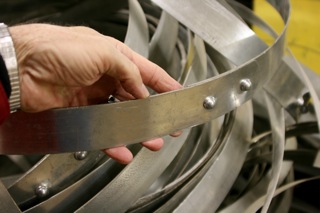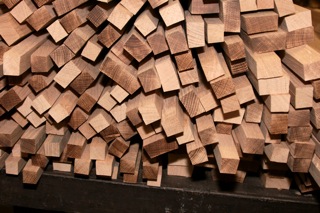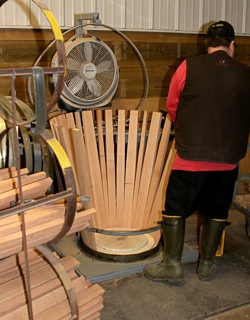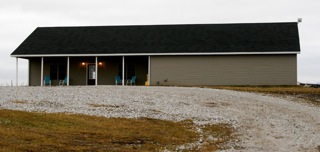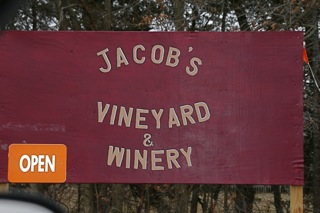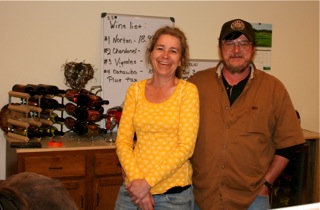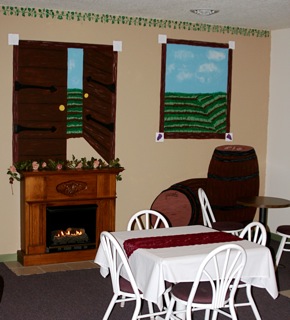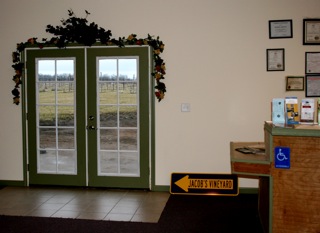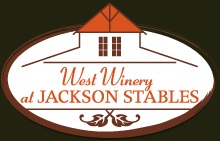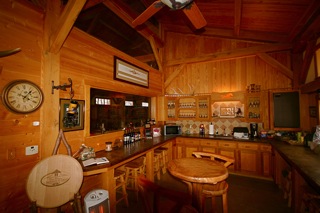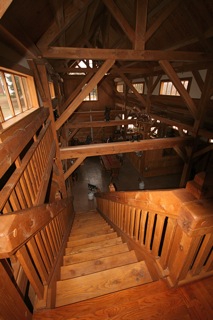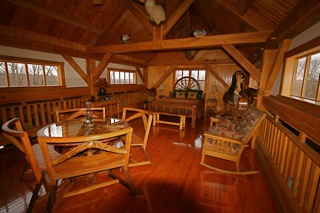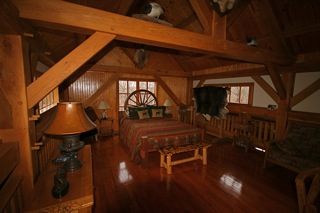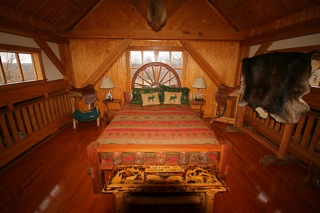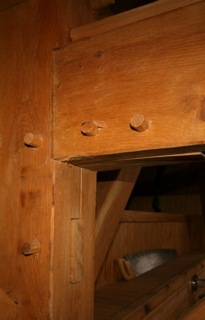As usual, when in Silver Rails Country (LaPlata,
Missouri Area), I like to check out all the many attractions in the area.
I've been in LaPlata to report on: The Depot Inn &
Suites' Chris Guenzler Million Mile Overlook, Exhibition of Amtrak
History, Silver Rails Event Center, Train Party, and now the Silver
Rails Gallery of Railroad Art. You can read my reports on all these
earlier trips at: http://trainweb.org/carl
Another Sweet, Suite Deal at the
Depot Inn & Suites, Western Suite
Upon our arrival in La Plata on the Southwest Chief: First, Bob
Cox was on the platform in La Plata welcoming us and helping passengers board
#4. Then Amy Cox grabbed our heavy suitcases and carted them to the
Hotel Van and took us to the Depot Inn & Suites.
As we walked in the door, Sally welcomed us by name and gave us our
keys to the Western Suite (She must have noticed that I had cowboy boots
on and knew there was a boot jack in that suite). Later in our stay,
Angie did a good job at the Manager's Reception, in addition to her housekeeping
duties at the Inn. .
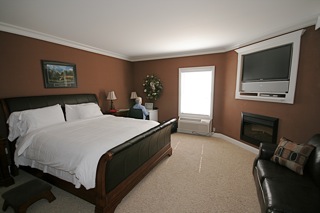
View of the Western Suite, as you walk in the door.
Note: Designer color, crown molding, leather covered king sized
sleigh bed, Leather couch, fireplace, giant screen TV, western art pieces,
stool to step up and into the plush bed.
|
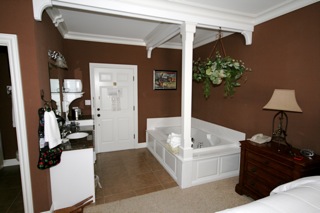
Looking back at the entry door from the center of
the room. Note the Jacuzzi tub, sink with marble counter, raised portion
of the counter for ice bucket and 4 plugs for chargers, and nice molding.
|
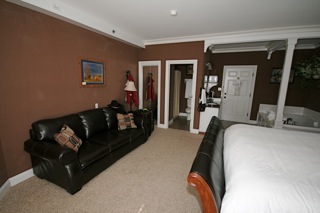
View of the room from near the window. Note:
leather couch (which makes into a bed), beyond the couch is a mirrored
closet door, and entry into the bathroom/shower.
|
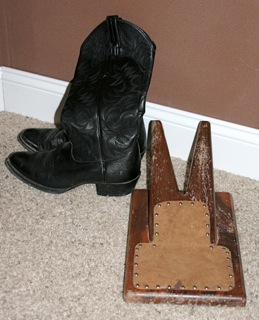
The boot jack in the Western Suite came in handy.
|
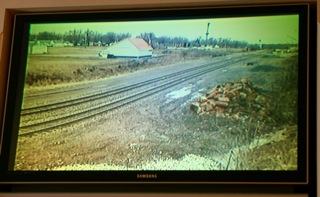
Channel 14 and 15 have the diagram of trains in
the area and a live shot of the BNSF track from the Overlook, looking west
toward the Depot. Keeping the TV tuned to this channel, when you hear a train,
just look at the TV to see it pass!
|
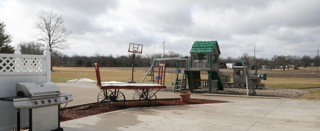
Outside the suites, beside the back parking lot,
is a patio area with grill and play area for children.
|
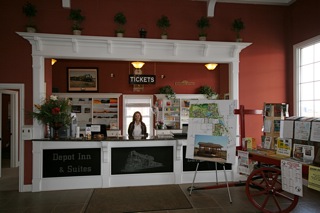
The front Desk and Andrea. Looks like a Train
Station ticket office.
|
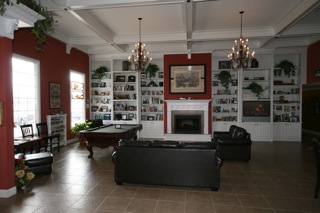
Opposite side of the Lobby with pool table, sofas,
fireplace, TV, other comfortable chairs, and bookshelves full of railroad
books and artifacts.
|
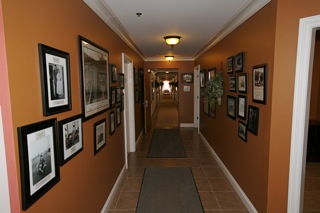
Hallway from the lobby to the 4 Suites, again lined
with railroad photographs.
|
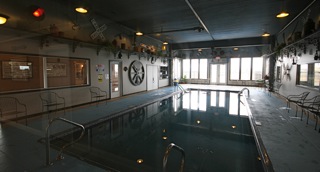
Large, heated, indoor pool can be seen from the
lobby, and hallway to the suites. There's even railroad artifacts poolside
and a steam engine water spout over the center of the pool and a train whistle!
|
Knowing that the weather forecast said the day we arrived
in La Plata would be the best day of our stay, we continued to Hannibal,
MO, on the Mississippi River, about 80 miles from the Depot Inn & Suites
in La Palta. To get to Hannibal from the Depot Inn and Suites, simply
drive south on Hwy. 63 to the Interstate-type Intersection with Hwy. 36 and
drive east. Take the "Downtown" exit and you'll be downtown in a few
blocks.
First we had home-made root beer and tenderloin sandwiches at the Mark
Twain Restaurant then Sue hit the Hickory Stick Quilt Shop as Tom and I railfanned
the river route and watched the muddy Mississippi flow south with ice and
fallen trees.
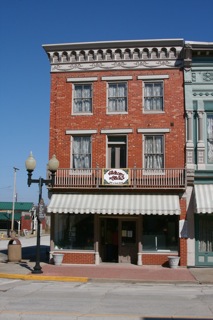
The Hickory Stick Quilt Shop
|
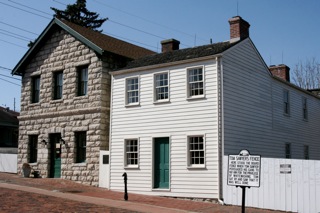
Mark Twain's Home, and the fence that Tom Sawyer
had kids pay him to paint.
|
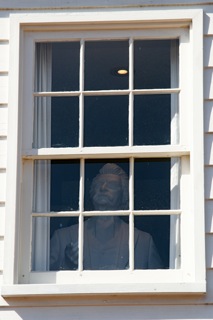
It is rumored that Mark Twain's ghost can be seen
in some second story windows.
|
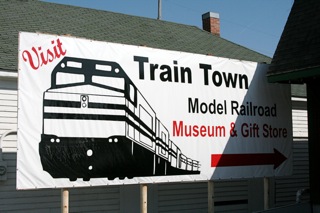
This big museum and gift shop are across the street
from the Mark Twain Restaurant.
|
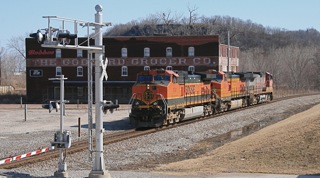
We walked two blocks east, toward the river, and
on the river side of the levy, Tom and I caught these BNSF locomotives delivering
some freight cars.
|
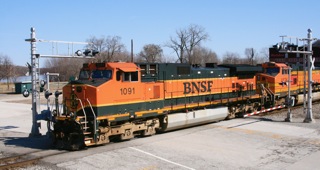
|
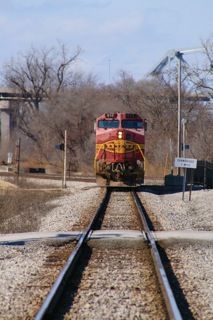
Soon, the locomotives returned with the full train
and headed south down the river toward St. Louis.
|
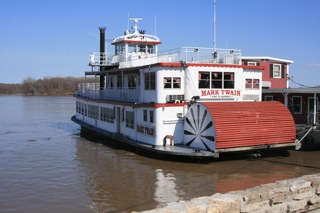
Tom and I continued on to the edge of the river,
only a half block from the tracks. The Mark Twain Riverboat's engines
were running, but tied up.
|

North up river, is the new I-72 bridge, that replaced
the Hwy. 36 bridge that used to cross into downtown Hannibal.
|
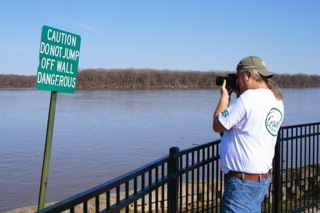
Tom and I followed all the rules, and just took
photos of "Old Muddy."
|

Beyond the Interstate Bridge, is the RR lift bridge.
It is much lower, and I imaging during floods must be under water.
|
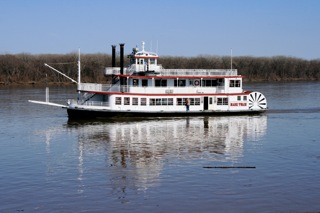
While watching the river, the Mark Twain Riverboat
pulled out into the river, turned, and came back in bow first.
|
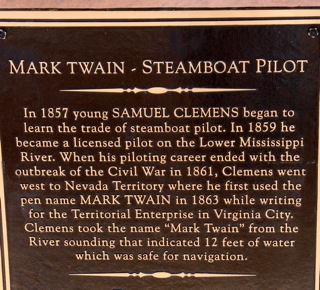
In the riverside park is this nice statue of Mark
Twain during his Riverboat Captain days.
|
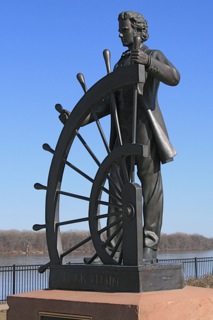
|
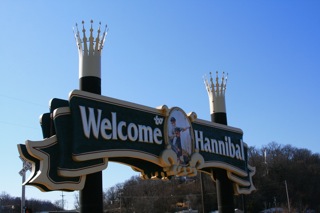
Modern day riverboats stop here so guests can visit
Hannibal.
|
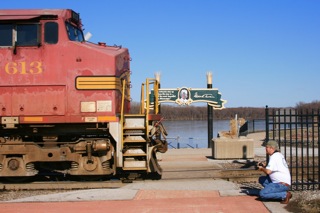
Tom got up close and personal as the BNSF train
headed down the river route.
|
After our visit to Hannibal, we returned to the Depot Inn & Suites.
We walked to the Red Rooster Restaurant for dinner, then had an excellent
night's sleep in those great king beds. Next morning, we had a continental
breakfast in the Lobby, and drove down the gravel path to the Chris Guenzler
Million Mile Lookout (below).
Chris is a personal friend of ours, and we were here for the dedication
of this train lookout.
Chris Guenzler Million Mile Lookout

Tom Anderson
|
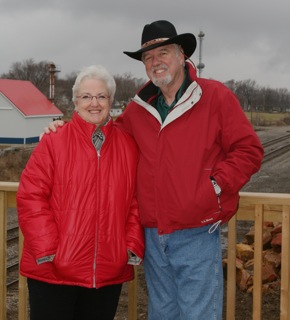
Sue and Carl Morrison
|

It's fun to see our old signatures inside the Lookout,
|
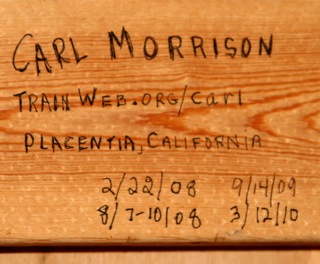
and to add the date each time we're here.
|
It was time to start the portion of the visit that Tom was here for --
Missouri Wineries in Silver Rails Country:
-
Cooper's Oak Winery
-
Jacob's Winery
-
West Winery
-
West Winery at Jackson Stables
We drove south of the Depot Inn & Suites on Hwy. 63 to Macon, just
past Hwy. 36. Through town on 36, we found Vine Street and turned right.
A few blocks to the downtown section and on the right before the "T"
downtown, was 107 Vine St., the new home of West Winery and Tasting Room.
Since my last visit, the address had been added above the roll-up glass
door, and the West Winery Logo was on the entry door.
West Winery, Macon, MO
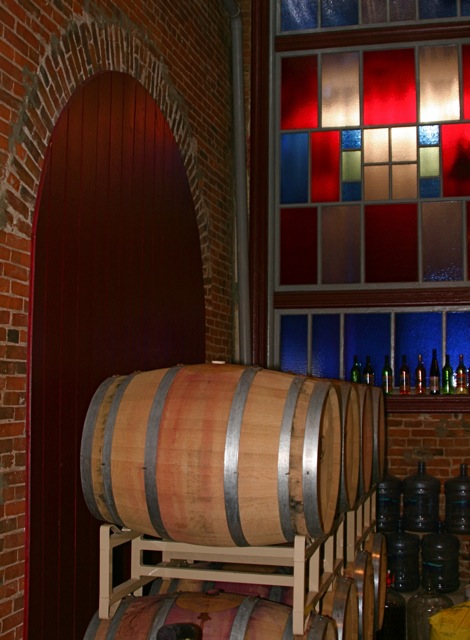

The south facing glass front to the Tasting Room
provides light in all seasons.
|
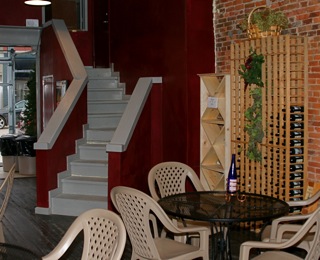
To the right of the front entrance are stairs to
the winery office.
|
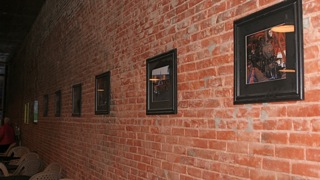
I'm proud to say that Chris and Jen selected many
of my train photographs for their tasting room walls. These photos
as well as photo note cards are for sale in the tasting room.
Additionally, they have used my train photographs on two of their Loco
Vino wines as well.
|
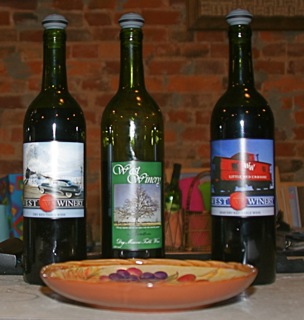
|
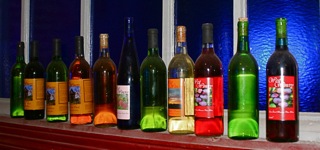
On the back winery wall is somewhat of a history
of the West Winery's production.
|
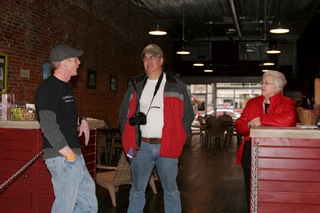
Chris (left) and Tom enjoyed discussing wine making.
|

In his winery, Chris uses Missouri White Oak barrels
that were made just down the road at A & K Cooperage in Higbee, MO. These
barrels were used in Napa California when they were new, then brought back
to Missouri for use in Chris' red wine making.
|

The oak wine barrels, stained glass windows and
brick arch reminded me of an earlier visit to an Abbey Winery.
|

|
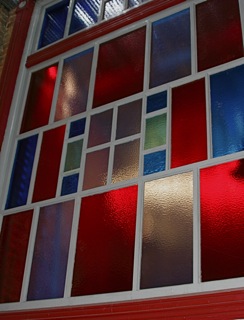
|
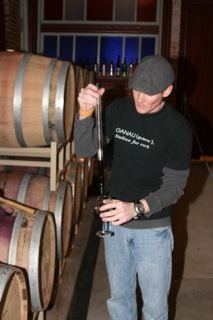
Chris gave us a rare treat - barrel sampling.
|
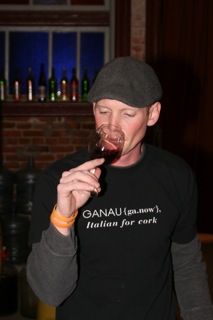
|
We also visited Cooper's Oak Winery in Higbee, MO. Cooper's
Oak Winery is about 55 miles south of the Depot Inn & Suites (58 minutes)
on Hwy. 63.
COOPER'S OAK WINERY
96-A WEST JONES STREET
P.O. BOX 218
HIGBEE, MO 65257
660-456-7507
Drive through Macon, and on south through Moberly to MO
State Road M to the right for 1.1 miles. Turn LEFT onto S MORLEY ST/US-63
BR. for .5 miles. Turn RIGHT onto MO-A/TERRILL RD. Continue to
follow MO-A, 7.4 mi. Turn LEFT onto W JONES ST. and you will see the Cooperage
on the left.
Tom had read that Cooper's Oak Winery was actually a cooperage
first, then they began making wine. They give wine barrel making tours,
which I was very interested in since I had never seen how barrels were made.
From Matt, we learned that they had two nearby suppliers of Missouri
White Oak. They are the only Cooperage and Winery on the same property
in the US and there are only 3 cooperages in all of Missouri. They
make 5 to 6,000 barrels a year.
A & K Cooperage has been producing white oak barrels
since 1972. Barrels from A & K are shipped to California, Texas,
ad Missouri. plus several other states and foreign countries. Each
barrel involves over 22 steps and while most of the work is done by machinery,
much hand work is required. Tours of the Cooperage are available by
appointment by calling 660-456-7227 or 660-456-7507. Tour hours are
Monday-Thursday 8 am to 3 pm. Fridays 8 am to Noon.
The Cooper's Oak Winery is located in the small town of
Higbee, in the gently rolling hills of north central Missouri. The intertwining
of cooperage and winery only enhances the winery offerings of Chambourcin,
St. Vincent, Michelle's Sweek Red and White, My Sweet Dear, as well as a
Cabernet Sauvignon and Merlot.
-- From their brochure.
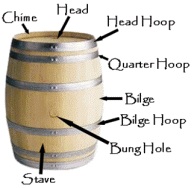 Parts of a Wine Barrel
Parts of a Wine Barrel
A wine barrel is made up of staves which have been shaped into a bulging
cylinder, and flat heads or ends. The staves are held in place by metal
hoops, usually galvanized on wine barrels or steel on whiskey barrels.
The shape is designed so the barrel can easily be rolled. The curve
or Bilge allows the barrel to be spun easily to control direction.
Most barrels weigh between 125 to 140 lbs. when empty. Six to eight
hoops encircle the barrel spaced along the length. Wineries can specify
the placement of the end hoops for placement on their storage racks.
Most cooperages tend to make wine barrels from white oak. White
Oak meets the requirements of porosity, strength, resilience, workability,
weight and character. The large thick rays of the wood give white
oak extra toughness and bend ability, while making it relatively stable
during dry shrinkage and wet swelling.
Logs must be hand split to preserve wood grain without breaking veins,
essential to making impermeable barrels. The logs are quartered to
obtain the wood used for the barrel staves. After splitting and planing,
the stave wood is stored in tiers, exposed to air and water as the wood is
naturally aged by weather. Through exposure to the elements, the wood
is purged of impurities, undesirable odors and harsher tannins which might
overpower the flavor of the wine. This aging process takes several
years.
After aging, the stave lumber is cut to proper length, tapered at each
end, beveled, planed on the outside and slightly hollowed on the inside.
After being inspected, they are given to the cooper for assembly.
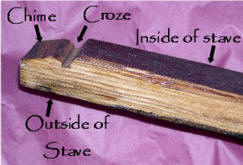 Construction of a Wine Barrel
Construction of a Wine Barrel
The cooper selects the best staves, assembling them inside a metal hoop
that acts as a jig. This operation is known as "mise en rose" or "raising
the barrel". Three metal hoops are forced into place, creating
a solid hold on the staves, which are then dampened by the cooper.
At this point, the "rose" or partially constructed barrel is placed over a
small wood fire. During this step, the inside of the barrel is charred
or "toasted". The amount of char has an effect on the wine aged in the
barrel. Winemakers can select from Light, Medium or Heavy Toast.
The Toast decision is made based on the variety of grape and style of wine
which will be aged in the barrel.
Wood fibers, rendered flexible by the heat and humidity, can now be bent
using a winch to gradually arch the staves and tighten them to obtain the
shape of the barrel. The staves are held trussed until metal hoops
are in place. The ends of the staves must be trimmed and a "croze" or
groove is cut in the staves to receive the barrel heads. Barrel heads
are custom cut to fit the "croze", and assembled using dowels and river reed
to make a perfect seal.
To finish assembly, the cooper sets up his barrel, fits the heads into
the "croze" and completes the final hooping with a large mallet. The
barrel is tested for impermeability and if passed, the cooper finishes the
barrel with final planing and sand papering to enhance the quality of the
oak and the perfection of workmanship. It takes approximately eight
man hours to produce a single wine barrel.
Life of a Wine Barrel
The average wine barrel has a useful life expectancy of about five years.
After that time, the barrel has imparted the flavorings of the oak into the
wine. After the initial life cycle of the barrel, most wineries purge
their old stock. (Matt says the barrels he sends to California are
shipped back for resale.) Often these barrels are cut in half and sold
as planters - not a very fitting end for a work of craftsmanship. Some
carvers create wine art for the wine collector and lover.
-- crafty-owl.com/cooperage.htm
More photos from A & K Cooperage
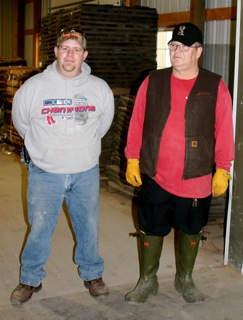
Two generations of Kirby Coopers, the "K" of A&K Cooperage.
|
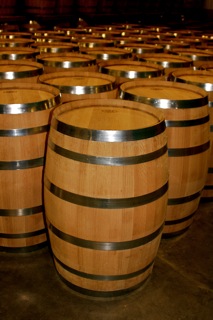
|
We then visited Jacob's Vineyard & Winery, 26078 Eagle Lane, Kirksville,
MO 63501. 660-627-2424. E-mail: jacobsvwinery@marktwain.net
Owners: Sheila and Russell Pruett.
Jacob's Vineyard and Winery is conveniently located about 10 miles
north of the Depot Inn via Hwy. 63, on the south side of Kirksville. Drive
to Eagle Lane (small road signs may make it hard to find, plus it is called
Eagle TRAIL to the left). If you get to the only stoplight north of
the Depot Inn & Suites, you have gone too far. Northbound, Turn
right off Hwy 63 onto Eagle Lane and drive about 1.3 mile until you see,
on your left, the 4' x 8' wine colored, "Jacob's Vineyard & Winery"
sign shown below. During that drive of one mile of rock road, you will
pass a restored Santa Fe Caboose on your right.
Once you turn onto the property, and up the incline, you will see the
winery and tasting room (below, left). As of this writing, they had
only been open a few months.
Their hours are: Thursday 11 am to 6 pm. (We arrived a little after
5 pm) Friday and Saturdays 11 am to 7 pm, or "By Appointment" after
hours by calling.
They also have Tasting Room Rental, Business Meetings, Showers, Class
Reunions, Bachelorett parties, etc. They will be ready for Weddings
beginning Spring of 2010.
A handout they had on the tasting room counter said: One Bottle
of Wine contains 750 ml of liquid. It takes 2.4 pounds of grapes to
make a bottle. There is 25.6 oz.. of wine in a bottle. There
are 4 glasses of wine in a bottle (6.4 oz. glass). Therefore it takes
2.4 pounds of grapes to make 4 glasses of wine, or .6 pounds per glass.
While tasting his wines, Russell was very informative about his new wine
business. One term I didn't know is "Agri-Tourism" when an agricultural
business brings in Tourists -- Like a winery.
22694 Rainbow Bison Trail, Kirksville, Missouri. Phone: 660.665.4611.
Fax: 660.627.5180
 COUNTRY
COUNTRY




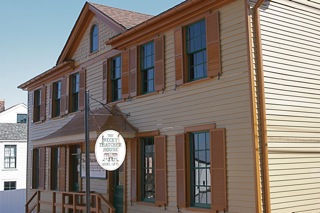
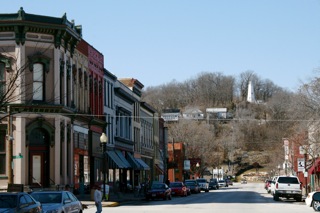









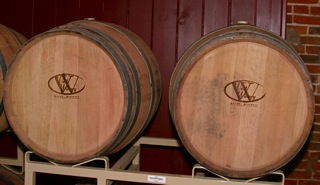
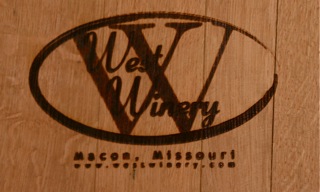
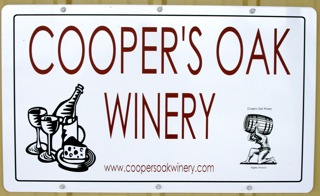
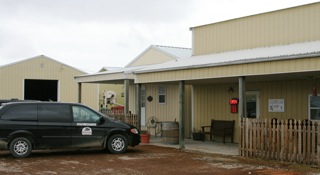
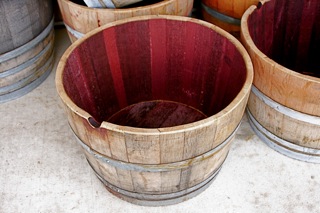
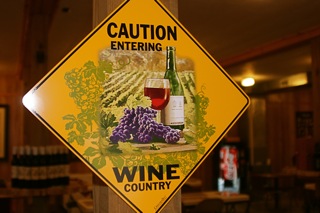
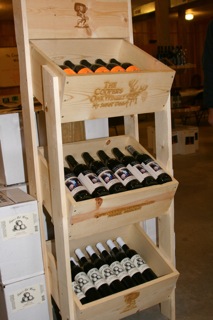
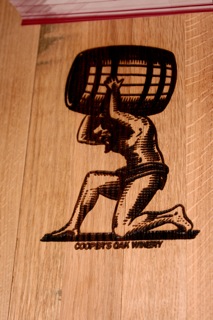
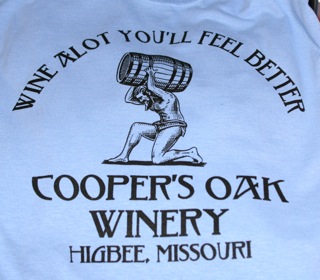

 Parts of a Wine Barrel
Parts of a Wine Barrel Construction of a Wine Barrel
Construction of a Wine Barrel